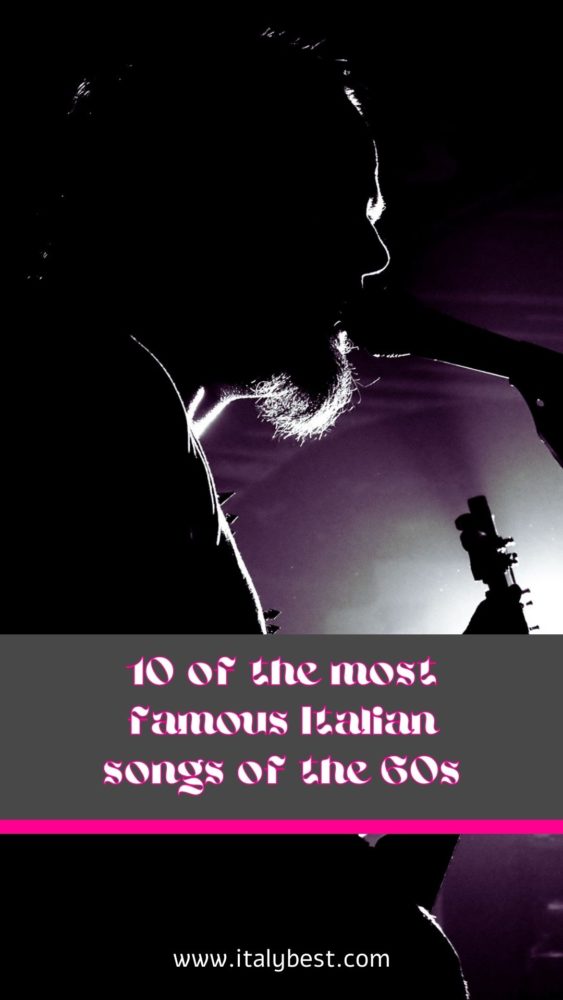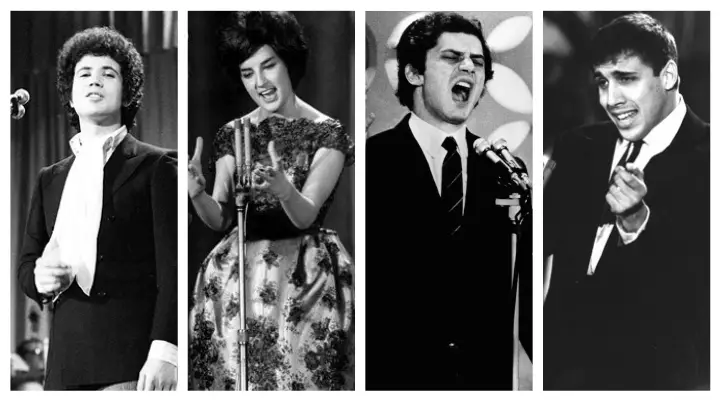In the early 1960s, there were two major innovations in the field of music and youth fashions: first, the expansion of the music market, secondly, the fact that the expansion concerned mainly young people. Many musical trends reflected the cultural transformations of those years. Many famous Italian songs are representative of this innovative period.
10 of the most famous Italian songs of the 60es
If you’re interested in the other collections, we prepared a list of the best Italian songs of the 70s as well as the 2000s’, classic songs, and the best Italian songs of all times.
In the 60es “beach songs” became popular, because also mass tourism began. These songs were almost always associated with new youth dances, at least a new one every year. A completely different world was one of the singer-songwriters of the 60s. They were intellectuals before singers, moreover, they took inspiration from jazz, French music, and existentialist philosophy. They promoted alternative values and styles. Songs denounced the conformism and hypocrisy of bourgeois society, as well as touching more intimate themes. In this article, we have collected the list of the most famous Italian songs of this decade.
1. La guerra di Piero
“La guerra di Piero” (Piero’s war) is a famous song from the early 1960s. Fabrizio de Andre’ is surely the author of some of the best Italian songs of all time. The song is about the contradiction of war. The point of view is the one of a simple soldier.
There are two voices: the narrator and the protagonist. The narrator is external and speaks in the third person, however, sometimes he exhorts the protagonist. The song, like a poem, talks about the contradiction between death and life.
2. ll Mondo
The song is by Jimmy Fontana “Il mondo” (the world) is one of the most beautiful Italian songs and one of his greatest hits. Fontana wrote the song in 1965. The text expresses the cyclical nature of life: the world does not stop whatever happens.
Everything we do and the feelings we experience have a relative impact on life itself. If we can stop loving or suffering, the world will keep turning and always moving forward. The song had a lot of success abroad snd it climbed the charts in Europe.
3. Sapore di Sale
“Sapore di sale” (Taste of salt) talks about forbidden love, made difficult by the constraints of the society of the time and by the differences in age and views. When, in 1963, the song was playing on all radios, the singer Gino Paoli attempted suicide by shooting himself.
The song is almost an omen of the end of the love story between Paoli and Stefania Sandrelli, did not seem suitable to become one of the most representative songs of the Italian summer, however, despite everything it succeeded and became one of the best Italian songs.
4. Il ballo del mattone
One of the best Italian songs of the summer of 1963. this song saw the triumph on the beaches and in the bars, thanks to the jukeboxes. Rita Pavone talked about flirts, not loves that had to end up with marriages. “Il ballo del mattone” (the brick dance), was an example of a new way of living the relationship.
She invited the partner not to be “jealous” and “furious” if she happened to dance with others the twist or rock.
Dancing on the brick literally meant, holding tight and moving so little that the space of one brick was enough to dance.
5. Ma che freddo fa
Nada, in 1969 participated in Sanremo Festival for the first time and even if her song “Ma che freddo fa ” did not win, it became the hit of the year. The song is about the end of love. After that life appears empty and aimless. She carries this sentimental cold for as long as she falls in love again.
6. Una rotonda sul mare
“Una rotunda sul mare” (a roundabout on the sea) is a piece of music sung in 1964 by the Italian singer Fred Bongusto, also a hit of the period. It became the soundtrack of the summer loves of several generations. The place, actually, is not on the sea, but on the lake. Precisely is the one of the Hotel Lido in Passignano on Trasimeno lake.
7. Mi ritorni in mente
The song was one of the best-selling of 1969. Lucio Battisti tells the story of the woman he loves and the moment when he realized that the love was over. The memory of his lover comes to his mind, however, the thought is torn by the memory of the moment when the girl asked him who was the another man dancing near them.
8. Lisa dagli occhi blu
Is a song from 1969 sung by Mario Tessuto. It was the best-selling single of the summer of 1969 and one of the most famous Italian songs of the 60es. The great success is due to the fact that the record created an atmosphere at home parties: the first dances, the lights out, the kisses. And in the background the mysterious Lisa, the protagonist of the song.
9. I Watussi
It was 1963 when Edoardo Vianello, at the age of 25, wrote and sang the song “I Watussi” for the first time. Like other songs by the Roman singer-songwriter, I Watussi is one of the most symbolic songs of the Italian sixties. Funny and catchy, in May 2010, the song was certified by the Guinness Book of World Records for having been played ten thousand times.
10. La coppia più bella del mondo
The song is built on a waltz that seems to be in contrast with the musical trends of 1967, however, Celentano has always made rock coexist with certain traditional rhythms. The philosophy of the song is that marriage is like a trip: you invent new games to extend your vacation. But you have to commit yourself. The goal is to live forever next to the person you love, even in bad times.
Wrapping up the most famous Italian songs of the 60s
The 60s were a golden age: the post-war recovery, the economic boom, and the technological development. So today certain songs play with their charge of optimism. Some of these pieces of music are evergreens and became famous even beyond national borders.
PIN IT: The Most Famous Italian Songs of the 60s



